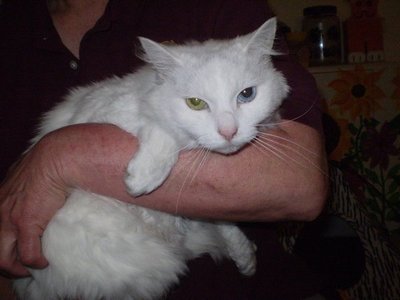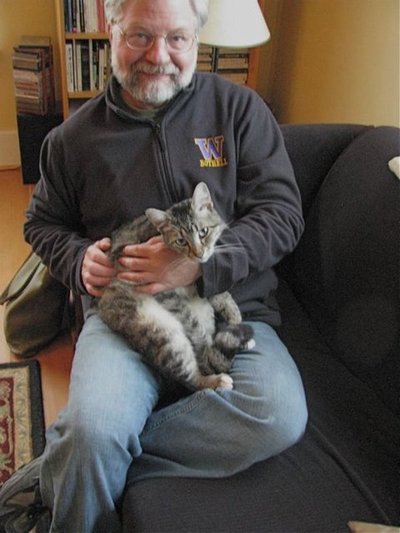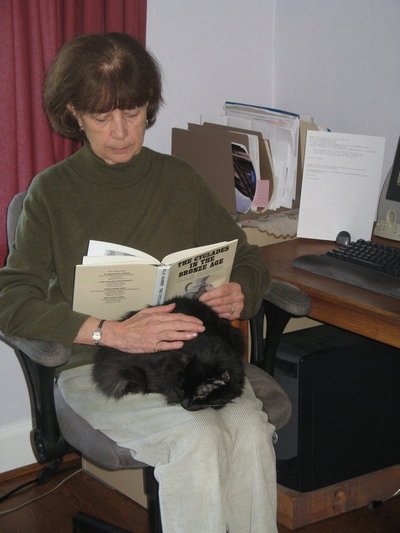October 28, 2010
Cats getting new homes, lives, through UWeek classifieds
Carol Crowell first saw Cosette in the University Week Classifieds. “In the picture, her eyes got to me because she looked like she felt that she was very unloved,” Crowell said. “My cat, Cosmo, had died three weeks before and I thought perhaps I could give Cosette a home.”
That home would be the first lasting home that Cosette had ever had. She was a long-abandoned pet living among the feral cats that the Friends of Campus Cats had been feeding — in her case, for about four years. “She wouldn’t let them catch her,” Crowell said. “She was very fast and she ran away. It wasn’t until some animal — maybe another cat or a raccoon — hurt her leg that she was caught.”
That’s when she was advertised for adoption on the classifieds and Crowell, who is a program assistant in the Robinson Center, saw the photo and ended up bringing her home. Cosette promptly went and hid under the bed, where she remained for two days. Crowell appealed to Sharon Talbert, the founder of Friends of Campus Cats, for help, and Talbert advised her to feed the cat some baby food. Crowell took the advice.
“She came right out, she ate up all the food, she looked at me and looked at her food; then she understood,” Crowell said. “I’ve had her about two years now. She’s very affectionate, very loving. She talks all the time, she plays. She’s just marvelous.”
It’s another happy ending for Talbert, a program assistant in the Information School, and her small group of volunteers, who have been rescuing feral and stray cats since 1988. It all began with several colonies of feral cats who were living and breeding on campus. Talbert and her friends began feeding them, capturing them and taking them to the veterinarian for health checkups and neutering. Cats or kittens who could be socialized were put up for adoption. Adult ferals who couldn’t be socialized were returned to their colonies to live out their lives. Friends of Campus Cats became an official nonprofit organization in 2000.
“To our knowledge, there are no more colonies on campus,” Talbert said. That doesn’t mean, however, aren’t any individual ferals here or elsewhere.
Staff on campus who find or are notified about feral or stray cats know that Talbert is the person to call. Only a few weeks ago, she said, someone in Facilities Services called her about a stray cat at the Physical Plant office building — in this case a tame one. She picked up the cat and took it to a vet, who searched it for a chip indicating ownership but found none. The cat has since found a new home.
Sometimes, Talbert said, the veterinarian will care for cats she brings in and find them homes. Other times, one of the three or four people in her group who provide foster care give the cat a temporary home until it is placed.
One of the people who has done foster care is History Professor Carol Thomas. For example, Thomas agreed to take Violet, a 13-year-old cat whose owner had just died.
“When I met Violet she was in a carrier,” Thomas said. “She was very large and extremely frightened by the unaccustomed confinement and the number of other cats. As Sharon realized, she needed a home without other animals.”
Thomas took the cat home and put her in a room away from her other cats. Then she called some good friends whose cat had just died. The friends agreed to take Violet, and the old cat had another seven or eight happy years.
Thomas also has a cat who started life as feral, one of a litter of three kittens rescued by Talbert’s group. Thomas initially took two of the kittens and got a friend to give one of them a home. She kept the other.
“She is black so I called her Mavra, which is Greek for black,” said Thomas, whose research specialty is ancient Greece. “She is beautiful and shy, but she is such a friend that I have to have two chairs by my desk so she can sit next to me while I work. She’s now 13.”
The electronic age has been a boon to Friends of Campus Cats, as they’ve used the UWeek Classifieds to find homes for their animals. Talbert calls the classifieds a “godsend” for her group. UW faculty and staff have regularly succumbed to the heartwarming photos. Take Tim Humes, for example, a counselor at UW Bothell. He saw a cat called Alex on the classifieds and contacted Talbert. Like all potential adopters, Humes and his wife were required to visit with Alex at his foster home before being allowed to take the cat home.
“We’re looking for a good match for the particular cat,” Talbert said of these visits. “It’s just something I’ve built over time — a sense of the animal and the person and who’s a good fit for whom.”
Potential owners are asked to bring family members, especially children, if any are involved, so that Talbert and her group members can see how they interact with the cat. Humes’ children are adults now, but he and his wife won approval to be Alex’s people.
“We brought him home, and he let us know right away that he had no intention of being an indoor cat,” Humes said. “Our windows open from the top, and he climbed the drapes and squeezed out the top of the window. My son brought him in and he ran right over to the curtain and started climbing again.”
No wonder, then, that Alex’s name was changed to Loxley, as in Robin of Loxley, as in Robin Hood. “When we haven’t seen him in a while,” Humes joked, “we say he’s gone to Sherwood Forest.”
But thanks to Friends of Campus Cats, he has a home now, and he always comes back.
For more information about Friends of Campus Cats, click here.



